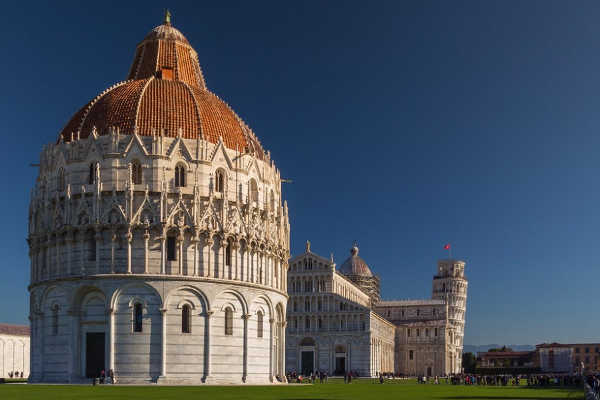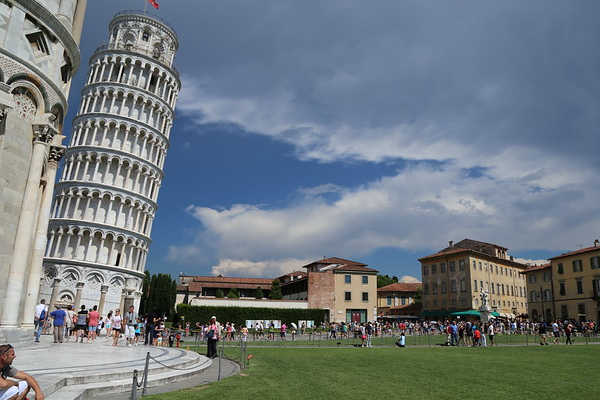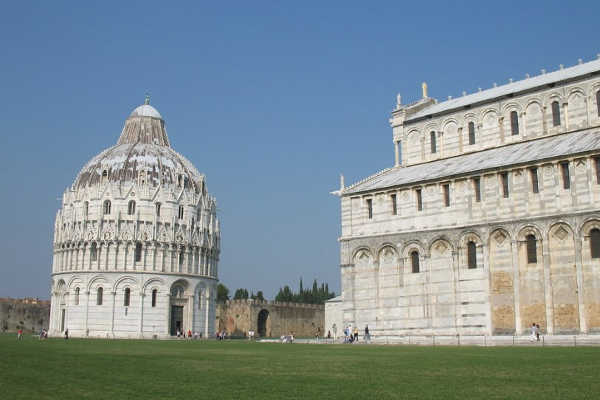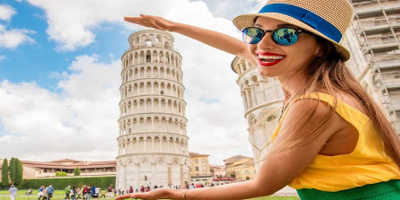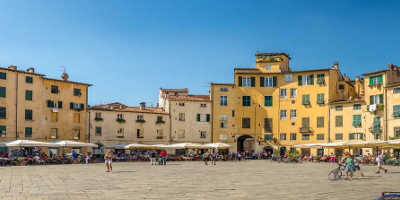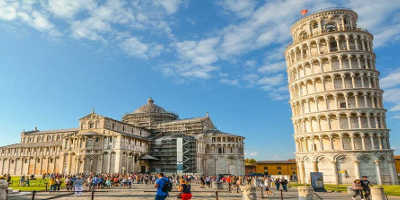Piazza dei Miracoli, Pisa
Standing in amongst some of the most beautiful and impressive buildings the world has ever known, you will be in no doubt as to how this square gained its miraculous title!
Medieval Italy’s grandest architectural project, Piazza del Miracoli, draws thousands of tourists every year from across the world. Also known as Square of Miracles, it flaunts four beautiful marble monuments standing out from the surrounding green expanse. From the Cathedral of Santa Maria with its world-famous leaning tower to the Baptistery and the Campo Santo cemetery, the structural marvels in Piazza del Miracoli vie for your attention.
What to see in the Piazza Del Miracoli?
-
Emblem of Pisan-Romanesque architecture
The Cathedral of Santa Maria Assunta, with its white marble façade and elliptical dome, is one of the most spectacular churches in Italy. From the enormous gold mosaic of Christ to the eight-sided pulpit sculpted by Giovanni Pisano, this cathedral is not just the centrepiece of the square but also a true treasure trove of Italian art. Just like its belltower, the cathedral too is sinking, with a few indications of this visible.
Contained within the cathedral are striped arches that span across tall columns. They divide the church into 5 naves and the overall internal style is reminiscent of a Roman Basilica. Of particular importance is the elaborate pulpit designed by Giovanni Pisano that was built around 1300. Even though it was constructed before the Renaissance period, it displays a similar artistic style and even Michelangelo travelled to see its immense beauty.
-
Gravity-defying Leaning Tower
The visually striking Romanesque-Gothic Leaning Tower is recognized worldwide for the few degrees at which it tilts. Stand in front of the tower and take a picture of yourself propping it up or climb the 294 steps of the spiral staircase and capture a snapshot from the top. As you climb the tower, you will feel the extent of the tower’s lean and though you are totally safe it can be an unnerving (and amazing) experience.
Built as a bell tower for the cathedral, the tower is made entirely from marble and is beautifully decorated with columns and archways circling every level. Until the 1990s, the tower’s inclination was increasing by 1mm every year until extensive restoration work took place to correct it. Supposedly, the tower should remain stable for at least the next 200 years so now is the perfect time to see this fantastic building and venture to its peak.
-
Acoustic Perfection in the Baptistery
The Baptistery on Piazza del Miracoli is the largest in Italy and is lavishly decorated with a statue of St John the Baptist on top. The highlight of a visit to the baptistry is a demonstration of the remarkable acoustics. Every half hour, a guardian enters the building, stands next to the font, and sings a few notes that echo around the internal walls. The sounds reverberate long enough to allow a solo singer to form a 3-part harmony. Climb to the upper levels inside the baptistry for a chance to take beautiful pictures of the interior while the haunting song of the guardian echoes around you.
The focal point of the baptistry is, of course, its baptismal font that was built by Guido Bigarelli. At the time of the construction of the Piazza Del Miracoli, unbaptised people were not allowed inside the church, so the baptistry was positioned beside it. In medieval times baptism was done by full immersion, hence why the font is so big. You can imagine both children and adults coming here to take part in the ritual that would save their eternal souls. In fact, the word ‘baptism’ derives from the Greek word for immersion.
Whilst in the baptistry, you will admire the marble pulpit that was built by Nicola Pisano. The carved images depict the Virgin Mary in various stages from the nativity to Jesus’s first bath and the realism he managed to convey would be emulated by Nicola’s son, Giovanni in his work on the pulpit of the duomo.
-
Ancient Monumental Cemetery
The Campo Santo in Pisa is enclosed by a large, oblong Gothic cloister where you’ll find sarcophagi and Roman graves. As the cemetery is built on sacred soil from the Holy Land of Golgotha, legend has it that bodies buried here rot in just 24 hours. Furthermore, there is also a large assortment of Roman sarcophagi, fresco paintings, and Roman sculptures to feast your eyes on.
Interestingly, the cemetery is the resting place of Leonardo Fibonacci, the medieval mathematician from Pisa who discovered an incredible series of numbers (the Fibonacci Sequence) that is still incredibly important today.
The cemetery features 3 chapels and houses a collection of historical relics. These include a thorn from Christ’s ‘Crown of Thorns’, two fragments from the ‘True Cross’, and a piece of fabric from the clothing of the Virgin Mary. Along the walls of the cemetery are one of the most striking of its features, its frescoes. Originally painted in 1360 they were partially destroyed by a bomb during the Second World War in 1944. Thankfully, both the cemetery and its frescoes underwent major restoration work and they can now be enjoyed in their former glory.
You can spend an entire day wandering around the sights of the Square of Miracles with its plethora of incredible architecture and relics. But if your time is limited and you’d like a tour of the most important aspects of the piazza, then book onto one of our informative and exciting tours.

